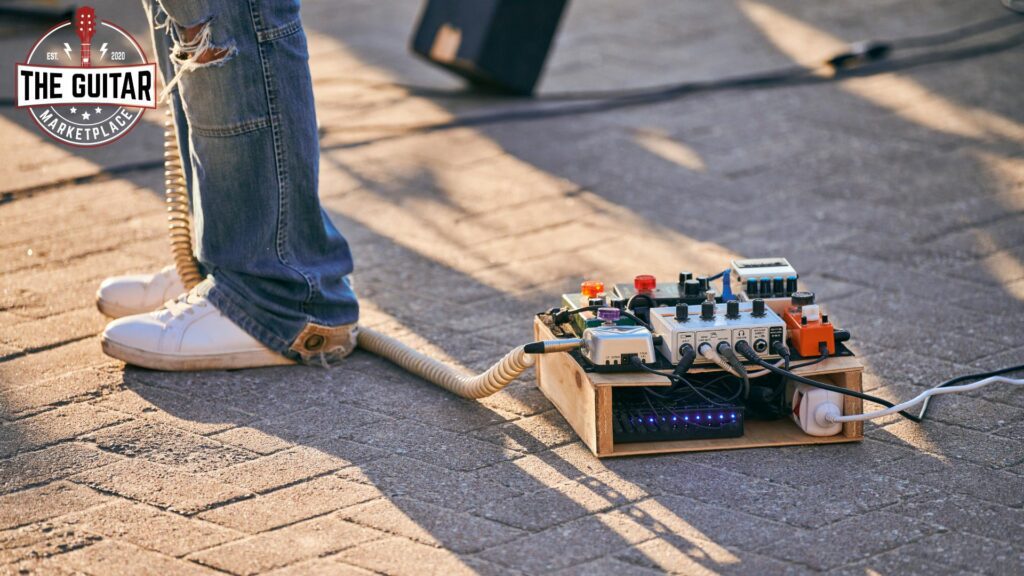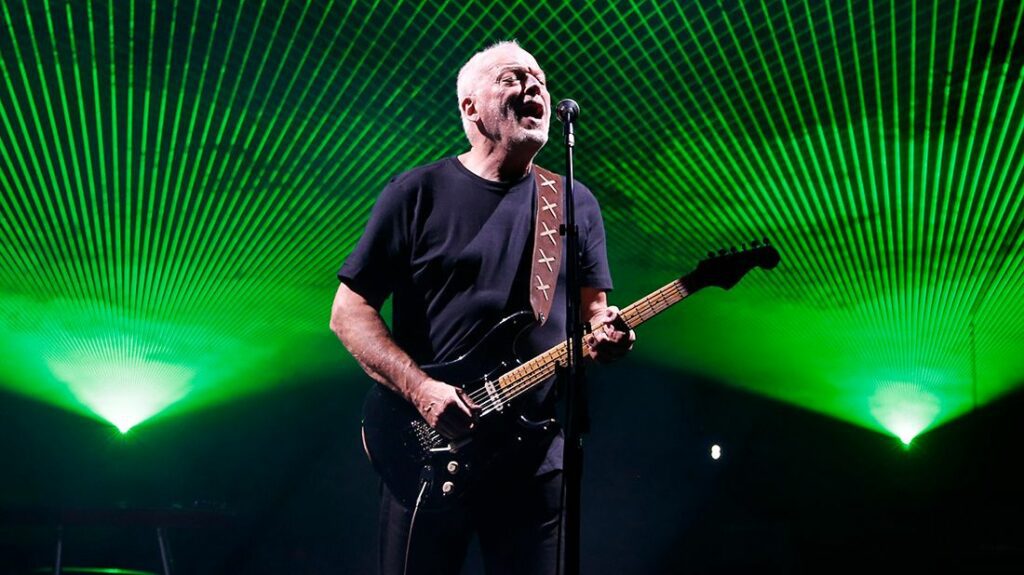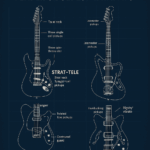Introduction:
In the vast realm of music, there exists an arsenal of tools that enable musicians to sculpt captivating sonic landscapes. Among these tools, guitar pedals reign supreme, offering a gateway to infinite creative possibilities. These small, unassuming boxes have the power to transform an ordinary guitar into a symphony of sound, imbuing it with character, depth, and emotion. They are the alchemical catalysts that bridge the gap between the musician’s imagination and the ethereal realms of music.
In this blog, we embark on an extraordinary journey into the realm of guitar pedals. From the raw power of distortion to the ethereal realms of reverb, we will delve deep into the various types of pedals, uncovering their mysteries, exploring their sonic nuances, and shedding light on how they shape the guitar’s tone. Whether you’re a seasoned guitarist seeking to expand your tonal palette or a budding musician eager to explore new sonic frontiers, join us as we unlock the secrets of these enigmatic devices.
Head over to our website so see what guitar pedals you can win INSTANTLY
What are guitar pedals?
Guitar pedals, also known as effects pedals or stompboxes, are small electronic devices designed to alter the sound of an electric guitar. They serve as intermediaries between the guitar and the amplifier, introducing various effects and manipulating the signal to create a wide range of tones and textures. These pedals are typically housed in compact, durable enclosures and are activated by stepping on a footswitch, hence the term “stompbox.”
Each guitar pedal is designed to produce a specific audio effect or modify the guitar’s signal in a particular way. From the distortion and overdrive that add grit and intensity to the smooth echoes of delay and the lush modulation of chorus, guitar pedals come in a variety of types, each offering its own sonic flavour. By incorporating these effects into their playing, guitarists can shape their sound, evoke emotions, and bring their musical vision to life.
Guitar pedals have become an integral part of virtually every genre of music, from rock and blues to jazz, metal, and beyond. They allow guitarists to explore new sonic territories, add depth and complexity to their compositions, and establish a unique sonic identity. With a vast array of pedals available, each with its own distinct characteristics, guitarists can curate their own personalized palette of effects, tailoring their tone to suit their musical style and artistic vision.
I. Different Types of Guitar Pedals:

Distortion Pedals: Distortion pedals are the sonic architects of rock ‘n’ roll rebellion. They harness the power of grit, aggression, and raw energy, allowing guitarists to unleash roaring riffs and blistering solos. From the legendary “screamer” pedals that define classic rock to the searing high-gain beasts that propel modern metal, we’ll dissect the inner workings of distortion pedals, unravel their sonic characteristics, and guide you towards finding the perfect one to manifest your desired sonic fury.
Popular distortion pedals and their characteristics –
There is a wide range of distortion pedals available on the market, each with its own unique tonal characteristics and sonic capabilities. Here are a few popular distortion pedals and a brief overview of their characteristics:
Ibanez Tube Screamer: The Ibanez Tube Screamer is one of the most iconic and widely used distortion pedals. It is known for its smooth and creamy overdrive tone, which is achieved by its signature midrange boost and warm clipping characteristics. The Tube Screamer excels at adding sustain, enhancing note definition, and delivering a classic bluesy or rock-driven tone.
Boss DS-1 Distortion: The Boss DS-1 Distortion is a legendary pedal that has been a staple on countless pedalboards for decades. It offers a versatile range of distortion, from mild overdrive to full-on distortion. The DS-1 is known for its tight and punchy tone, making it suitable for a wide variety of genres, including rock, punk, and metal.
Pro Co RAT: The Pro Co RAT (RAT stands for “Real And Totally” overdriven) is a highly regarded distortion pedal that has gained popularity for its versatility and wide-ranging tonal options. The RAT can produce anything from a smooth and bluesy overdrive to a heavy and aggressive distortion. It is known for its dynamic response and the ability to cut through the mix with its distinctively edgy and saturated tone.
Fulltone OCD: The Fulltone OCD (Obsessive Compulsive Drive) is a sought-after pedal loved for its transparent and amp-like overdrive to high-gain distortion capabilities. It provides rich harmonic content, touch sensitivity, and a wide gain range. The OCD can take you from a clean boost to crunchy rhythm tones or soaring lead sounds with clarity and definition.
Electro-Harmonix Big Muff Pi: The Electro-Harmonix Big Muff Pi is an iconic fuzz/distortion pedal that has left an indelible mark on the music industry. It produces a thick and saturated fuzz tone with a pronounced sustain and aggressive character. The Big Muff Pi is renowned for its ability to create massive walls of fuzz, making it a favorite among players in genres like stoner rock, psychedelia, and alternative.
Overdrive Pedals: Often misunderstood as mere siblings of distortion, overdrive pedals possess a unique sonic charm of their own. These versatile tone-shapers add warmth, texture, and richness to your guitar’s voice, breathing life into bluesy licks, soulful melodies, and driven rock anthems. We’ll demystify the subtle distinctions between overdrive and distortion, explore the iconic overdrive pedals that have etched their legacy in music history, and empower you to infuse your playing with nuanced, expressive tonal magic.

Delay Pedals: As time bends and echoes reverberate, delay pedals transport your sound into captivating dimensions. They infuse your playing with mesmerizing trails, cascading repeats, and rhythmic patterns that breathe life into your musical tapestry. We’ll unravel the secrets of delay pedals, examining their intricacies, exploring the diverse array of delay types, and introducing you to the iconic units that have graced countless albums. Prepare to embark on a sonic journey through the vast corridors of time.
At its core, a delay pedal captures the incoming guitar signal, stores it temporarily, and then plays it back after a set amount of time. This delayed playback creates the perception of echo or repetition, effectively extending the duration of the original sound.
Controls and Parameters: Delay pedals offer various controls and parameters that allow you to shape the desired echo and repetition effects:
Delay Time: The delay time control determines how long the delay pedal waits before playing back the delayed signal. By adjusting this control, you can achieve short slapback echoes, medium-length delays, or long, atmospheric reverberations.
Feedback/Regen: The feedback or regen control determines the number of repeats or echoes. Higher settings result in more repetitions, while lower settings produce fewer repeats and a shorter decay time.
Level/Blend: The level or blend control lets you adjust the mix between the original signal and the delayed signal. This control allows you to blend the delayed echoes seamlessly with your dry guitar sound.
Additional Parameters: Some delay pedals may offer additional parameters like modulation, filtering, or tap tempo functionality. Modulation adds subtle pitch variations to the delayed signal, creating a swirling or chorusing effect. Filtering controls allow you to shape the frequency response of the echoes, emphasizing or attenuating certain frequencies. Tap tempo functionality enables you to synchronize the delay time with the tempo of your music.

Famous guitarists who utilise delay guitar pedals –
David Gilmour (Pink Floyd): David Gilmour’s ethereal guitar soundscapes and iconic solos in Pink Floyd’s music owe a great deal to his use of delay effects. His skillful implementation of delay pedals, particularly the Electro-Harmonix Deluxe Memory Man, can be heard in songs like “Comfortably Numb” and “Shine On You Crazy Diamond,” where he creates atmospheric textures and mesmerizing echoes.
The Edge (U2): The Edge is renowned for his distinct guitar sound, characterized by an extensive use of delay and echo effects. He often employs delay pedals such as the Line 6 DL4 and the TC Electronic Flashback in U2’s music, creating rhythmic patterns, soaring solos, and cascading delays that are integral to the band’s signature sound.
Johnny Marr (The Smiths): Johnny Marr’s intricate guitar work in The Smiths often incorporated delay effects to create a jangly, atmospheric sound. His rhythmic arpeggios and melodic lines, as heard in songs like “How Soon Is Now?” and “This Charming Man,” were enhanced by the use of delay pedals like the Boss DM-2, contributing to the band’s unique sound.
Modulation Pedals: Within the realm of modulation lies a realm of sonic enchantment. Chorus, phaser, flanger—the names themselves evoke imagery of ethereal landscapes, swirling textures, and evolving sonic waves. Modulation pedals infuse your guitar with movement, depth, and an otherworldly allure. We’ll delve into the inner workings of modulation effects, unravel their captivating soundscapes, and introduce you to the legendary pedals that have painted sonic masterpieces throughout the ages.
Reverb Pedals: When your guitar’s notes dance through vast chambers, shimmer in expansive halls, or embrace the intimate depth of a small room, it is the spellbinding work of reverb pedals. These devices create an immersive sense of space, transforming your guitar into an instrument that resonates within ethereal realms. We’ll explore the concept of reverb, unravel its role in adding dimension and atmosphere to your playing, and introduce you to a range of popular reverb pedals, each with its own unique sonic characteristics. Get ready to transport your listeners to breathtaking sonic landscapes.
How reverb pedals work –

Reverb is an essential effect that plays a significant role in shaping the sonic landscape of music. It simulates the natural reverberation that occurs in different acoustic environments, adding a sense of space, depth, and ambiance to audio signals. Let’s explore the concept of reverb and its role in creating immersive soundscapes.
Reverb, short for reverberation, refers to the persistence of sound reflections in an enclosed space after the sound source has stopped. When a sound is produced in a room, it travels to various surfaces, such as walls, ceilings, and floors, and bounces off them. These reflections mix and interact with the original sound, creating a complex blend of echoes that gradually decay over time.
In the realm of music production and audio effects, reverb is achieved through the use of digital algorithms or physical devices known as reverb units. These units replicate the characteristics of different acoustic spaces, such as concert halls, chambers, plates, or springs, and apply the simulated reverberation to the audio signal.
Creating a Sense of Space: Reverb helps to create a sense of physical space within a recording or performance. It gives the impression that the sound is occurring in a specific environment, whether it’s a small room, a cavernous hall, or an expansive outdoor setting. By adding reverb to a dry, close-miked recording, you can make it sound as if the performance is taking place in a larger, more reverberant space.
Enhancing Depth and Dimension: Reverb adds depth to audio by creating a sense of distance between the listener and the sound source. The reflections and decay of reverb contribute to the perception of objects and instruments occupying different positions in a three-dimensional sound field. By adjusting the parameters of reverb, such as decay time and early reflections, you can manipulate the perceived depth and spatial positioning of elements in the mix.
Establishing Mood and Atmosphere: Different reverb settings can evoke various moods and atmospheres. A short, subtle reverb can add a sense of intimacy or closeness, while a long, lush reverb can create a dreamy, ethereal quality. The choice of reverb type and settings can help establish the desired emotional tone of a musical piece, whether it’s a haunting, cavernous sound for a ballad or a bright, spacious feel for an energetic pop track.
Blending and Gluing Elements: Reverb acts as a unifying element that helps blend disparate sounds together in a mix. By applying a consistent reverb to different instruments or vocal tracks, you can create a cohesive sonic environment, making them sound as if they belong in the same space. This cohesive blending can contribute to a more polished and professional-sounding production.
Adding Texture and Interest: Reverb can also be used creatively to add texture, movement, and interest to a sound. By applying modulation or pre-delay to the reverb, you can create subtle variations or rhythmic patterns within the decay, enhancing the overall character of the sound. This can be particularly effective in ambient music, soundscapes, or atmospheric guitar parts.
Reverb is a powerful tool for adding space, depth, and atmosphere to music. By simulating the natural reverberation of different acoustic environments, reverb enhances the sonic experience, immersing the listener in a rich and immersive soundscape. From creating a sense of space and depth to establishing mood and texture, reverb is a versatile effect that plays a crucial role in shaping the overall sonic identity of a musical piece.
II. Choosing the Right Guitar Pedal:
The process of selecting the perfect guitar pedal is both exciting and daunting. With a multitude of options available, it’s essential to consider various factors that will influence your sonic journey. We’ll guide you through the decision-making process, discussing the importance of factors such as budget, musical style, and desired tone. By understanding your specific needs, you can make an informed choice and find the pedal that resonates with your musical vision. Furthermore, we’ll provide valuable tips on how to effectively test and compare pedals, whether it’s through hands-on experimentation, researching reviews and demos, or even borrowing or renting pedals before committing to a purchase. Embrace the adventure of discovery as you embark on a quest to find the perfect sonic companion.

III. Building a Pedalboard Setup:
Organizing and integrating your pedals into a cohesive pedalboard setup is key to unlocking their full sonic potential. We’ll take you on a journey through the essential components and considerations for building a well-rounded pedalboard. From choosing the right power supply to understanding pedal order and signal flow, we’ll provide insights that will help you optimize your tone and create a seamless musical experience. Whether you’re a beginner looking for a straightforward setup or an experienced player aiming for a complex rig, we’ll explore common pedalboard layouts and configurations to suit a range of musical styles and preferences. Additionally, we’ll share tips for cable management and troubleshooting, ensuring that your pedalboard setup remains reliable and inspires you to push the boundaries of your creativity.
Choosing the Right Pedalboard: The first step in building your pedalboard setup is selecting the right pedalboard itself. Consider factors such as size, durability, portability, and the number of pedals you plan to use. Pedalboards come in various shapes and sizes, from compact and lightweight options for minimal setups to larger boards capable of accommodating extensive pedal collections. Assess your needs and preferences to find a pedalboard that suits your playing style and gigging requirements.
Power Supply Considerations: A reliable power supply is crucial for a pedalboard setup. It provides consistent, clean power to your pedals, ensuring optimal performance and reducing the risk of unwanted noise or signal degradation. Look for a power supply with sufficient outputs to accommodate your pedals and consider features like isolated outputs for minimizing noise and voltage regulation for stable power delivery. It’s also essential to choose a power supply that matches the voltage requirements of your pedals (typically 9V or 18V).
Pedal Order and Signal Flow: The order in which you place your pedals in the signal chain significantly affects your tone. While there are no strict rules, certain guidelines can help you achieve the desired sound. Generally, the signal flow starts with dynamic-based effects (such as compressors or wah pedals), followed by gain-based effects (distortion, overdrive), modulation effects (chorus, phaser), time-based effects (delay, reverb), and finally, any additional EQ or volume pedals. Experimentation is key, and you may discover unique sounds by deviating from conventional signal chains.
Patch Cables and Signal Integrity: High-quality patch cables are essential for maintaining signal integrity and minimizing unwanted noise in your pedalboard. Invest in low-capacitance cables with sturdy connectors to ensure reliable connections and minimal signal loss. Keep the cable lengths as short as possible to reduce the chances of signal degradation and noise interference. Neatly arrange and secure your cables to avoid accidental pulls or tangles during performances.
Velcro or Pedalboard Tape: To keep your pedals securely in place on the pedalboard, consider using Velcro or pedalboard tape. Attach one side of the adhesive material to the bottom of your pedals and the other side to the pedalboard’s surface. This allows for easy rearrangement of pedals while ensuring they stay firmly in place during performances, even when subjected to stage vibrations and movement.
Cable Management: Efficient cable management not only enhances the visual appeal of your pedalboard but also reduces the risk of accidental unplugging or damage. Use cable ties, zip ties, or cable organizers to bundle and route your cables neatly along the edges or underneath the pedalboard. Consider using a cable routing solution such as cable channels or a pedalboard with built-in cable routing features to streamline the process.
Gig Bag or Case: Protecting your pedalboard during transport is essential, especially if you frequently gig or travel with your setup. Invest in a sturdy gig bag or a hard case designed specifically for your pedalboard’s size and shape. This ensures that your pedals remain safe from impacts, spills, and environmental hazards while on the move.
Remember, building a pedalboard setup is a personal and iterative process. It may take time to find the ideal layout, pedal placement, and organization that suits your playing style and preferences. Continually experiment, listen, and refine your setup to create a pedalboard that enhances your musical expression

IV. Maintenance and Care for Guitar Pedals:
Click here to check out Gear4Music’s pedal page!
To ensure that your pedals continue to perform flawlessly and stand the test of time, proper maintenance and care are essential. We’ll provide practical guidance on cleaning and protecting your pedals, preventing common electrical issues and signal loss, and troubleshooting potential problems that may arise. By implementing effective maintenance practices, you can preserve the integrity of your pedals and prolong their lifespan. Additionally, we’ll explore considerations for storage and transportation, safeguarding your beloved pedals from damage while on the go. A well-maintained pedal collection will serve as a reliable creative companion, ready to deliver sonic bliss whenever inspiration strikes.
V. Exploring Experimental and Unique Guitar Pedals:
For those seeking to venture beyond the boundaries of conventional guitar tones, there exists a realm of experimental and unique guitar pedals. These unorthodox devices push the boundaries of sonic exploration, offering a plethora of unconventional sounds and textures. We’ll introduce you to a world where glitchy bitcrushers coexist with ambient granular synthesizers, and where pedals with mind-bending functions inspire new avenues of creativity. Embrace the spirit of sonic experimentation and step into a realm where innovation knows no bounds.
Introduction to unconventional and niche pedals
While distortion, delay, and reverb pedals are commonly found on many pedalboards, the world of guitar pedals extends far beyond these familiar effects. Exploring unconventional and niche pedals opens up a realm of sonic possibilities that can inspire creativity and push the boundaries of your playing. These pedals, often characterized by their unique designs and specialized functions, offer guitarists a chance to experiment with unconventional sounds and textures.
Unconventional and niche pedals come in a variety of forms, catering to specific musical genres or experimental approaches. They may include fuzzes with unusual filtering capabilities, glitch and granular effects that manipulate audio in unexpected ways, or even pedals that generate synth-like tones. These pedals can add a distinct flavour to your sound, allowing you to craft music that stands out from the crowd.
One of the fascinating aspects of exploring unconventional pedals is the element of discovery. With less mainstream recognition, these pedals often come from smaller manufacturers or boutique builders who are passionate about pushing sonic boundaries. They are built with care, attention to detail, and a dedication to providing unique sonic experiences. As a result, using these pedals can spark new ideas, spark creativity, and lead you down unexplored musical paths.
When considering unconventional and niche pedals, it’s important to keep in mind your personal playing style, musical preferences, and desired sonic outcomes. Experimentation and open-mindedness are key in exploring these pedals, as they may offer unconventional controls, parameter interactions, or unexpected results. Embracing the unconventional can lead to exciting sonic adventures and unlock fresh dimensions in your playing.

Examples of unique guitar pedals and their unconventional sounds
Electro-Harmonix Mel9 Tape Replay Machine: This pedal emulates the sound of vintage tape-based Mellotron keyboards. It produces lush and haunting orchestral sounds, including strings, choirs, and brass sections. With its ability to transform your guitar into an ensemble of Mellotron-like textures, the Mel9 opens up a world of atmospheric and cinematic possibilities.
Red Panda Particle: The Particle is a granular delay and pitch-shifting pedal that manipulates your guitar’s signal into fragmented and glitchy textures. It slices your sound into tiny grains and rearranges them, creating intricate patterns and evolving sonic landscapes. From shimmering textures to chaotic bursts, the Particle delivers experimental and unpredictable sonic adventures.
EarthQuaker Devices Rainbow Machine: This pedal defies conventional expectations, producing otherworldly and ethereal sounds. It combines pitch-shifting, modulation, and harmonizing effects to create cascading harmonies, bizarre detuned tones, and unpredictable arpeggiated patterns. The Rainbow Machine adds a touch of surrealism and unpredictability to your playing.
Death By Audio Echo Dream 2: The Echo Dream 2 is a hybrid delay and fuzz pedal that offers a unique blend of warm analogue delay and gritty fuzz distortion. It creates a distorted and warbled tape-like echo effect, adding a vintage and lo-fi character to your sound. The pedal’s unconventional controls and interactions allow for a wide range of atmospheric and unpredictable delay textures.
Chase Bliss Audio Thermae: The Thermae is a truly unique analogue delay pedal that incorporates a pitch-shifting algorithm inspired by vintage rack-mounted harmonizers. It allows you to create cascading delays with shifting harmonies and intricate pitch intervals. The pedal’s “Sliders” feature enables real-time manipulation of pitch intervals, resulting in unconventional and evolving delay textures.
Meris Enzo: The Enzo is a versatile synthesizer pedal that transforms your guitar into a polyphonic synthesizer. It offers a range of synth sounds, including monophonic leads, lush pads, and complex arpeggios. With its extensive control options and modulation capabilities, the Enzo unlocks a world of synth-inspired tones and experimental sonic landscapes.

Conclusion:
Guitar pedals are the enchanting tools that empower guitarists to transcend the limitations of their instruments, unlocking boundless creative expression. Throughout this blog, we have embarked on a captivating journey, exploring the various types of pedals, offering guidance in selecting the perfect ones, and providing insights into building an optimized pedalboard setup. Now armed with this knowledge, you can embark on your own sonic odyssey, shaping breathtaking tones, and immersing yourself in a world of infinite musical possibilities. Embrace the power of guitar pedals, and let your music soar to new heights.
CHECK OUT OUR BLOG POST ON BUYING SECOND HAND TO SEE WHERE YOU CAN BUY PEDALS
-
 Boost Your Odds – Win Tickets Instantly!£1.99Per Entry
Boost Your Odds – Win Tickets Instantly!£1.99Per Entry -
 Valeton GP-50 Multi-FX, Amp Modeller & IR Loader Pedal£0.05Per Entry
Valeton GP-50 Multi-FX, Amp Modeller & IR Loader Pedal£0.05Per Entry -
 Positive Grid Spark 2 Combo Modelling Amp£0.10Per Entry
Positive Grid Spark 2 Combo Modelling Amp£0.10Per Entry -
 Gretsch G5420T Electromatic in Sunburst£19.99Per Entry
Gretsch G5420T Electromatic in Sunburst£19.99Per Entry -
 1993 Gibson Les Paul Bass in Cherry – B-Stock Bargain£0.25Per Entry
1993 Gibson Les Paul Bass in Cherry – B-Stock Bargain£0.25Per Entry -
Product on sale
 Gibson Les Paul Standard ’60s in Iced TeaOriginal price was: £3.30.£2.99Current price is: £2.99.Per Entry
Gibson Les Paul Standard ’60s in Iced TeaOriginal price was: £3.30.£2.99Current price is: £2.99.Per Entry -
 Fender American Performer Stratocaster in Satin Lake Placid£2.99Per Entry
Fender American Performer Stratocaster in Satin Lake Placid£2.99Per Entry -
 Free Wild Wednesday Giveaway! Spend £0 & Win a NUX ’59 Bassguy Overdrive or Spend £20+ & Win a Fender Standard Series Stratocaster£0.00Per Entry
Free Wild Wednesday Giveaway! Spend £0 & Win a NUX ’59 Bassguy Overdrive or Spend £20+ & Win a Fender Standard Series Stratocaster£0.00Per Entry -
 Fender American Special Telecaster in Vintage Blonde£0.99Per Entry
Fender American Special Telecaster in Vintage Blonde£0.99Per Entry







